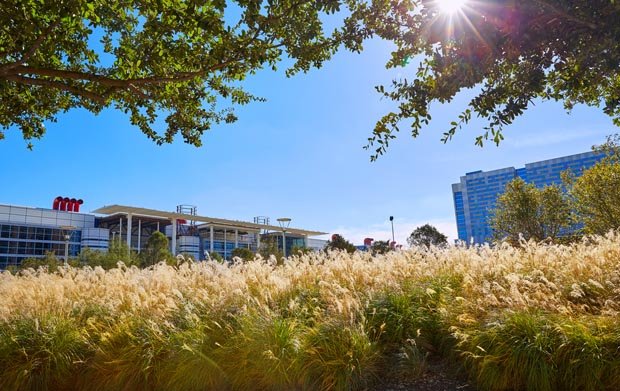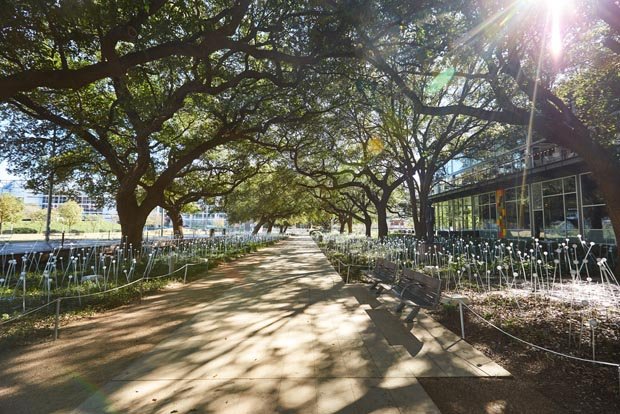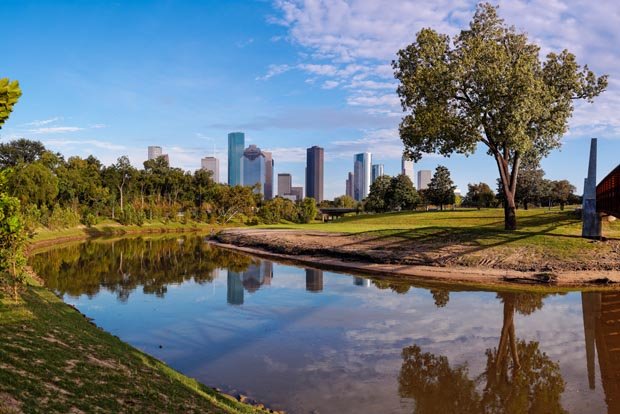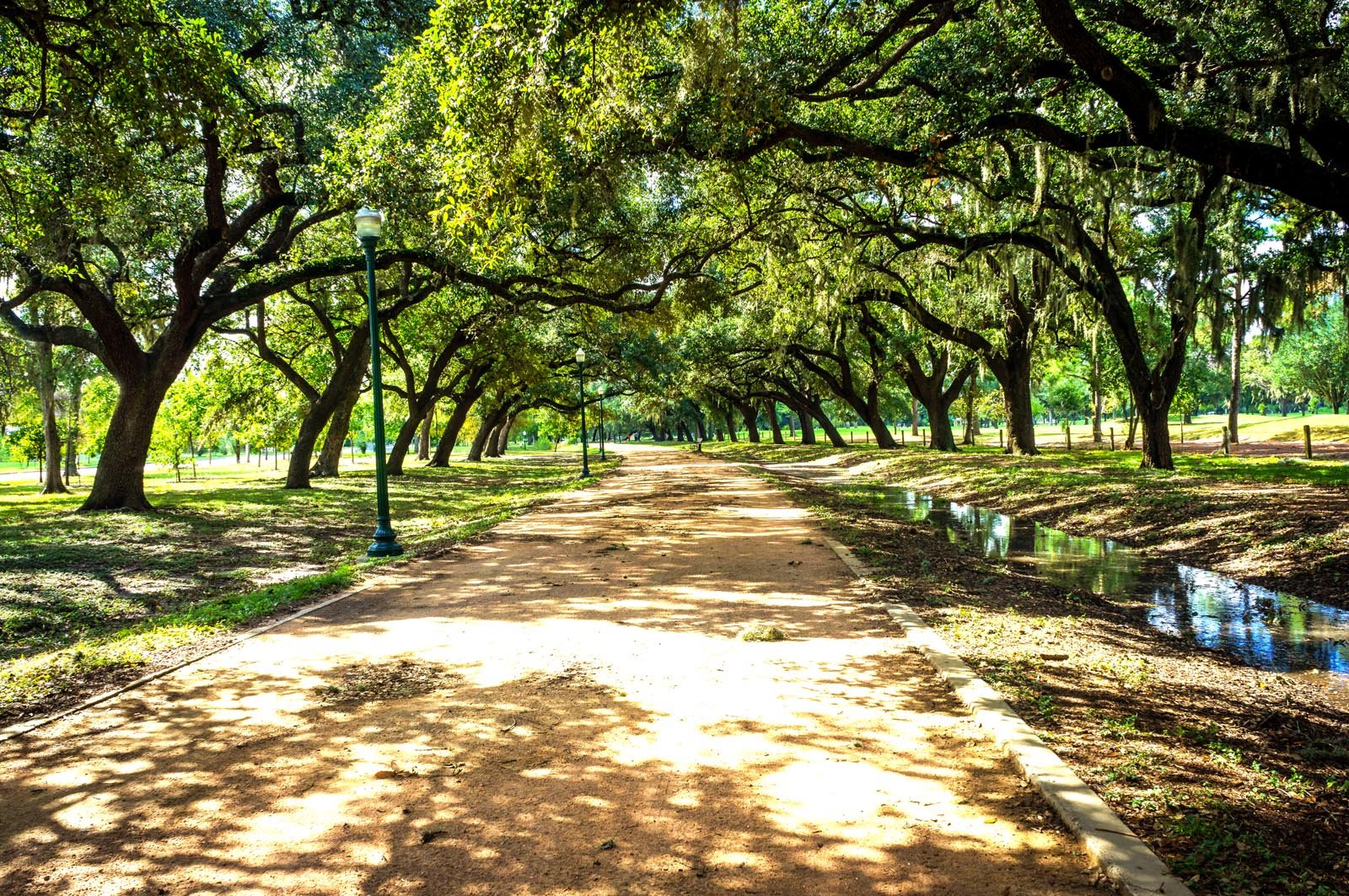Shinrin-yoku is the Japanese practice of “forest bathing,” a practice somewhere between Zen meditation and natural treatment that aims to put you in touch with nature and yourself. And it’s delightfully simple: all you need to do is slowly and mindfully enjoy a living forest! That can mean walking slowly or barefoot, maybe hugging some trees, or just enjoying nature’s many smells.
The health benefits of shinrin-yoku are well researched; experts believe that the combination of sunlight, light physical activity, a meditative enjoyment of nature, and organic compounds called phytoncides have profound psychological and physiological effects on your health. Plants, and especially trees, create phytoncides, which have a positive effect on everything from stress to immune function.
While a real, immense forest is ideal, immersing yourself in one of Houston’s many amazing green spaces and parks can be just as effective. So get out there and get forest bathing in one of these relaxing spots!
(8 of) The Best places to forest bathe (Shinrin-Yoku) in Houston
Discovery Green

Courtesy of Shutterstock
The Discovery Green has 12 acres of vibrant green space in the heart of the city, that is a great place to give forest bathing a try. The brainchild of a group of committed Houston philanthropists, the Discovery Green is a centre for cultural life that hosts hundreds of events throughout the year, so after a calming walk, you might even be able to drop by for one of those.

Courtesy of Shutterstock
Thanks to the efforts of these philanthropists, the Green was able to secure the space and develop it into a world-class green park with lots of grass for barefoot walking, quiet spaces with tall trees, interactive fountains and a spectacular lake. Sunny days at the Green are fantastic!
Houston Arboretum
Just outside downtown Houston, the Arboretum is another wonderful place not too far out of the way where you can reconnect with nature. The Arboretum lets you experience the natural world as it’s meant to be: you can touch the trees, walk barefoot through the grass and smell the fragrant air. The Arboretum’s 155 acres of wooded parkland have been conserved beautifully, so much that you’ll forget you’re still in the city.
The Arboretum is an ecologically-focused nonprofit, too, oriented towards educating people on the native biodiversity of the Houston area and the importance of preserving it.
The Arboretum has the added benefit of some amazing exhibits and gardens. The Arboretum’s Discovery Room has a great learning centre with exhibitions about the natural habitat of the Houston area, as well as a Nature Shop with tons of educational material for “nature lovers of all ages” and plenty of all-natural products.
Wildlife Garden is a great place to walk and meditate too, as you’re bound to see hummingbirds, butterflies and other wildlife that thrives in the Arboretum. The Carol Tatkon Sensory Garden shows how native plants can appeal to your senses, which is perfect for a mindful forest bath.
Lake Houston Park
With almost 5,000 acres of pristine wilderness, Lake Houston Park is another need-to-visit park in your search for amazing forest bathing spots. The park is only 30 miles north of Houston, where the Caney Creek River and East Fork of the San Jacinto meet.
The foliage, wildlife and spectacular views of the rivers at sunset give you much to take in as you breathe deep and relax, feeling the soothing calm of the forest. The shores of Lake Houston are a great place to stroll, and you can even sail onto the lake from one of the many creeks and rivers that empty into it throughout the park. Peach and Caney Creek are especially unforgettable!
The Park has many spots off the beaten path for you to discover, including charming small lakes and ponds, its more remote campsites, or Lake Houston itself. Lots of pine and cypress populate the woods here, giving it an amazingly healing fragrance (evergreens release tons of phytoncides!). You’ll also find wildlife of all types and, most importantly, no civilization in sight!
Sheldon Lake State Park & Environmental Learning Center
Sheldon Lake State Park has 1,200 acres of incredibly preserved land, 800 of which are permanently inundated and 400 that are vital marsh and swamp lands. Nature walks and forest bathing here will have a distinct calming and healthy effect, as the park is home to healing oak, pine, cypress, and different species of water lilies, as well as a very diverse range of wildlife.
After your forest bath, drop by the Environmental Learning Center (which you can also reach by Beaumont Highway) for some enlightening classes on subjects like pond ecology, animal adaptation, catch and release fishing, renewable energy, native gardening, composting and recycling.
Buffalo Bayou

Courtesy of Shutterstock
The 52-mile slow-moving waterway that is Buffalo Bayou provides some amazing opportunities for a nature stroll. Walk beside the pristine banks of the bayou for hours, seeing both the city in the distance and nature up close in all its beauty. Once you feel the light breeze on your face and see the beautiful light reflecting off the water, you’re sure to feel your stress begin to fade away.
The site of Houston’s founding in 1836, Buffalo Bayou connects practically the entire city and keeps the natural state of the area intact, making for an urban ecosystem with lots of wildlife and flora to discover. The Bayou is home to many trees, native grasses and beautiful, well-lit winding trails through many local parks.
Armand Bayou Nature Center
You’ll love forest bathing at the Armand Bayou Nature Center, one of the largest urban wilderness preserves in the U.S. The Armand Bayou has 2,500 acres along the Texas Gulf Coast of vital and beautiful wetlands, expansive green forest with calming trails, golden prairies where the bison graze and the natural and typical marsh habitats that are common to the Houston area. These are preserved so well that you’ll be able to soak in all the phytoncides, fresh air, and healthy sunlight you need.
The Armand Bayou is a sanctuary for 370 species of birds, mammals, reptiles, and amphibians, as well as home to tons of native plants. You can take on the many trails, taking the opportunity to feel the tree bark, grass, leaves and moss, or you can see the majesty of the Bayou from the viewing platforms. The Armand Bayou is a top birding location where you can go forest bathing for hours on end.
You can really get the most out of your day at the Bayou after you’ve relaxed and meditated in nature. Take the opportunity to explore the paddle and hiking trails, to go on a canoeing trip or a guided tour of the Bayou. If you are a little nocturnal and love birding, you should go on the Night Owl Prowl and spot some of these majestic birds in their natural habitat.
Day or night, you’re sure to see American alligators, hawks, river otters, whitetail deer, and several species of turtles. The Armand Bayou Education Center even has lots of snakes and spiders. Alternatively, you can take a trip back to the 1890s at the Martyn Family Farm, where they show you what it took to make it on the Bayou back then.
Mercer Botanic Gardens
Houston’s Mercer Botanic Gardens is another list-topping spot for forest bathing. The biodiversity the park boasts is just stunning; the Prehistoric garden, for example, is home to primitive plants that have existed for millennia, and the Shade Gardens feature some unique and exciting specimens.
Thelma and Charles Mercer purchased the original 14 and a half acres of the park in the late 1940s. Thelma, an avid horticulturist, brought many native species to the Gardens, which lie along the beautiful Cypress Creek, doing much of the work of clearing the land and planting herself.
The Gardens still feature many of her favourite trees, many of which are also native to Houston, like dogwoods, rusty black-haw viburnum, several types of hawthorns and stunning large camellias; in the years since, the Gardens have grown to over 300 acres.
Japanese Garden
Finally, why not take a trip to the home of Zen without leaving the city? Houston’s jaw-dropping Japanese Gardens can take you there. Your stress is sure to melt away as you relax here, surrounded by lovely waterfalls, wooden bridges, cobbled paths, and an unmistakable sense of serenity. The Japanese Garden was designed by Ken Nakajima, a renowned landscape architect. His design brings Japan to the heart of Texas and aims to engage your senses with its incredible arrangement of myrtles, azaleas, Japanese maples, dogwoods, and cherry trees with pink leaves.
Caught at the right time, the Japanese Garden blooms with the fragrant smell of lotus, Taiwanese Cherry trees, Japanese black pine and apricots, as well as olive trees, Wisteria, Camellia and even bamboo. The Japanese Garden was also designed specifically only to use natural materials like wood, soil and stone, making it ideal for an escape from our artificial world.

